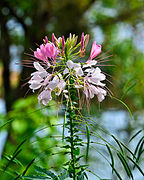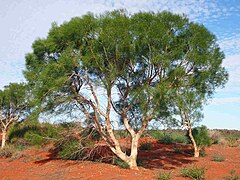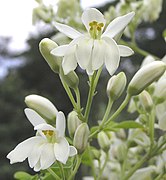Brassicales
| Brassicales | |
|---|---|

| |
| Alliaria petiolata, garlic mustard (Brassicaceae) | |
| Scientific classification | |
| Kingdom: | Plantae |
| Clade: | Tracheophytes |
| Clade: | Angiosperms |
| Clade: | Eudicots |
| Clade: | Rosids |
| Clade: | Malvids
|
| Order: | Brassicales Bromhead[1] |
| Families | |
| |
The Brassicales (or Cruciales) are an
APG II system.[2] One character common to many members of the order is the production of glucosinolate (mustard oil) compounds. Most systems of classification have included this order, although sometimes under the name Capparales (the name chosen depending on which is thought to have priority).[3]
The order typically contains the following families:[4]
- Akaniaceae – two species of turnipwood trees, native to Asia and eastern Australia
- Bataceae – salt-tolerant shrubs from America and Australasia
- Brassicaceae – mustard and cabbage family; may include the Cleomaceae
- Capparaceae – caper family, sometimes included in Brassicaceae
- Caricaceae – papaya family
- Cleomaceae[1]
- Gyrostemonaceae – several genera of small shrubs and trees endemic to temperate parts of Australia
- Koeberliniaceae– one species of thorn bush native to Mexico and the US Southwest
- meadowfoamfamily
- Moringaceae– thirteen species of trees from Africa and India
- Pentadiplandraceae– African species whose berries have two highly sweet tasting proteins
- mignonettefamily
- Salvadoraceae – three genera found from Africa to Java
- Setchellanthaceae
- Tiganophytaceae
- Tovariaceae
- Tropaeolaceae – nasturtiumfamily
Classification
The following diagram shows the phylogeny of the Brassicales families along with their estimated ages, based on a 2018 study of plastid DNA:[5]
| Brassicales families | |||||||||||||||||||||||||||||||||||||||||||||||||||||||||||||||||||||||||||||||||
| |||||||||||||||||||||||||||||||||||||||||||||||||||||||||||||||||||||||||||||||||
| Phylogentic relationships based on data from plastid DNA. The numbers next to each branching point indicate its estimated date (million years ago). Families with more than 30 species are in bold. |
On 20 April 2020, a newly described monotypic species from
Koeberliniaceae.[6]
Historic classifications
Under the
Moringaceae
. Other taxa now included here were placed in various other orders.
The families Capparaceae and Brassicaceae are closely related. One group, consisting of paraphyletic Capparaceae.[3] Therefore, this group is generally now either included in the Brassicaceae or as its own family, Cleomaceae.[4][7]
Gallery of type genera
-
Akania bidwillii (turnipwood family)
-
Batis maritima (turtleweed family)
-
Brassica oleracea (cabbage family)
-
Capparis spinosa(caper family)
-
Carica papaya(papaya family)
-
Cleome hassleriana(spiderflower family)
-
Emblingia calceoliflora(slippercreeper family)
-
Gyrostemon ramulosis (buttoncreeper family)
-
Koeberlinia spinosa (allthorn family)
-
Limnanthes douglasii (meadowfoam family)
-
Moringa oleifera (horseradish-tree family)
-
Pentadiplandra brazzeana(oubli family)
-
Reseda lutea (mignonette family)
-
Salvadora persica (toothbrush-tree family)
-
Tovaria pendula (stinkbush family)
-
Tropaeolum majus (nasturtium family)
Setchellanthaceae is sometimes known as the azulita family.[8]
References
- ^ hdl:10654/18083.
- (PDF) from the original on 2022-10-09.
- ^ PMID 21665611.
- ^ JSTOR 25065731.
- PMID 29574686.
- .
- S2CID 86218316. Archived from the original(PDF) on 2011-04-01. Retrieved 2016-08-26.
- ISBN 978-0-226-52292-0.
External links
 Media related to Brassicales at Wikimedia Commons
Media related to Brassicales at Wikimedia Commons
















